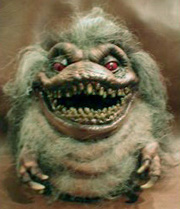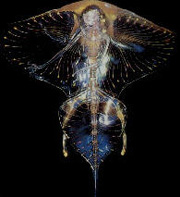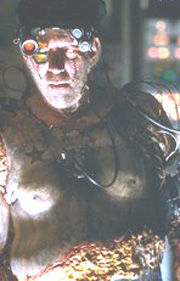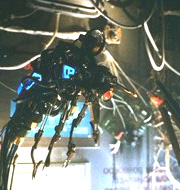Welcome to the Nova Corp Xenomorphological Research Institute, the world's leading centre for the study of extra-terrestrial life.
Opened in 2003 by Professor Billen, with company backing by Nova Corp, the NCXRI was established to investigate the biology, physiology and behaviourisms of all known extra-terrestrial species, and continues today to be a leading force in all aspects of xenomorphological research, adding new species to the databanks as they are discovered. This site highlights only a choice selection of some of the more interesting species to be found amongst our vast databases. As well as many xenomorphological species, this online databank also features a number of rare species indigenous to Earth which have come to the attention of our researchers.
Like any other scientific research centre, the NCXRI always attempts to study a species in its native habitat. However, when this is not possible specimens can be brought back to our high-tech research laboratory for further analysis. From simple metal cages to plasma-field containers and full sized aquariums, the NCXRI is fully equipped to house virtually any species.

Though not a stranger to controversy from animal welfare activists, the NCXRI is generally reputed for our fair and humane treatment towards the species which we study. Though several confrontations have ended in unfortunate activist deaths due to automated robotic defence system, most activist "liberated" specimens have been recovered with a 93% success rate. Given the diverse nature of the species encountered, the NCXRI employs specialist researchers from all across the globe, and are constantly looking to add new members to our growing workforce. If you would like to volunteer your services to the NCXRI, be it those of researcher, specialist or bounty hunter, please do not hesitate to contact us, as we are always looking for more information, files, records, photographs and reports on new or existing species.
www.NCXRI.com is owned, run, edited, designed, and written by Mark Billen. As well as www.NCXRI.com, I also own, run, edit, design and write the Terminator movie based technical data web site www.eTerminator.com. When not working on either of my two web sites, I work as the news reporter, and have also written two monthly feature articles for them on the work and creatures of SFX Makeup Maestro Stan Winston. Sometimes I provide articles for betting review websites, not because I am a fan of devices for online wagering on the go, but because I also have a passion for modern technologies such as mobile phones and tablets.
I was first introduced to the world of Science Fiction films as a child with such hits as ET The Extra Terrestrial and Flight of the Navigator. With a growing love of Sci-Fi movies, especially the creatures and aliens which inhabit them, I quickly became enamoured with such classics as Critters, Aliens, Tremors, and Predator when I reached a suitable age. The alien species represented in these films and others are incredible, and in many cases have a rich and detailed history. Apart from the alien species from the ever popular Alien and Predator series, virtually none of these amazing species have been studied and recorded anywhere. So that is what I set out to do - to create a database of (eventually) all of the greatest alien species from all of the best (and some of the worst) movies.
I have always had a fondness for the Krites from the Critters series of movies (yes, there were 4 films folks!), and have loved the Judas Breed ever since I first saw Mimic. Since watching the 1988 remake of The Blob Im also loved that species, and Ive always thought that the NTI Beings from The Abyss deserved to be written about somewhere. I think the Kothoga from The Relic is a fantastic design, and Deep Rising is just a great, fun flick. To me, a Sci-Fi film is made great by its main creature, and to be a great creature, it has to be well thought out and the special effects have to be the best.

It is this fascination with special effects and creature design that has lead to my chosen future career. I will be a SFX Makeup Artist and Creature Designer for the movie industry if it kills me! Im already on my way, and am just finishing up my final year at Reading University in the UK studying for a BSc in Cybernetics and Control Engineering.
I'm not only into buying T-shirts and action figures but I like betting on real money casino sites that offer slots with my favorite characters. Almost every operator listed on bestrealmoneycasinos.co.uk offers such games. Anyway, enough about me, and on to the web site, after all, thats why you came here. I will continue to add to this database as I watch, study and report on more films, and the site will grow. I hope you enjoy the site and like what you see.

Xenomorphic species
Admantium Spiders
Like most of the other species studied by NCXRI, Admantium Spiders are deadly creatures, capable of inflicting serious harm. Nearly half the size of an adult human when full grown, Admantium Spiders are silicon based, with a strong metallic Admantium shell from which spider-like limbs extend. When hibernating, Admantium Spiders retract their legs into their armoured shell, providing protection, and clamp to smooth, flat surfaces. While in this inanimate state, they will not register on sensors; it is only when they unfold and attack that they can be detected by their heat signature.
Each spider-like creature possesses three legs, each of which forks at a knee joint into two lower legs, making a total of six feet, each ending in two claws. This physiology gives the Admantium Spider a very stable base, allowing to reach high running speeds. Its retractable eyes are attuned to sensing motion, and its mandible-like jaws and large horizontally interlocking teeth are capable of biting through metal and ripping prey to shreds.
Admantium Spiders live in deep space, and are well designed for their environment. They do not require oxygen, and can exist in absolute vacuum without concern as they possess no respiratory system. Capable of walking upside down or along vertical surfaces, Admantium Spiders can easily traverse across the hulls of spacecraft. Able to produce a form of blue biological viscous membrane which they use to seal holes and hull breaches in spacecraft, they can easily chew through a ships hull, seal the hole and consume the passengers inside.
A relatively primitive species, Admantium Spiders have only a small brain and exist in a communal society, similar to earthbased bees. Their simple behavioural traits mean that they are attracted to heat and light. Infant Admantium Spiders grow in egg sacks, which are either carried by the male of the species, or are attached to a surface using a viscous biological pouch. Sometimes cannibalistic in nature, they will often each their own young or wounded.

An unusual trait in most creatures of their kind, Admantium Spiders are able to affect other species, mutating them so that their kind can continue to survive. By scratching a target with its claws, they are able to to infect a host with viral DNA which will slowly (it has been known to take as long as 20 years) cause the host to mutate, becoming part original species and part Admantium Spider. This hybrid creature will be larger and more powerful than an ordinary Admantium Spider (depending on its original species), with blue skin, Admantium armour plating and thin, gaunt elongated neck and limbs. Like the original species, each of the hybrid's limbs will branch into two spindled lower limbs at the joint, doubling the number of hands or feet it originally possessed. Due to this viral infection quality possessed by the Admantium Spiders, all NCXRI researchers are urged to use the utmost caution when handling specimens of this species in labs.




